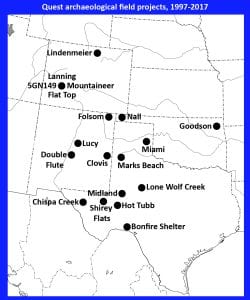The Quest Archaeological Research Program was established at SMU in February, 1996, with a generous endowment from Joseph L. Cramer (1919-2013) and Maude Ruth Cramer of Denver, Colorado. The endowment’s stated purpose is to advance our understanding of the first peoples to come to the Americas in Late Pleistocene times, with a major emphasis on archaeological sites “considered to have Paleoindian occupations present in surface and/or subsurface contexts.” Although he was born in Clovis, New Mexico, the town that lent its name to what was long thought to be the earliest culture in the Americas, Cramer strongly believed that the first Americans arrived south of the continental ice sheets in pre-Clovis times. He was right.
In the more than two decades since its establishment, the Quest endowment has supported a range of investigations, a substantial portion of which has involved archaeological fieldwork on Paleoindian sites located on the Great Plains and in the Rocky Mountains. The first large scale, multi-year Quest project was at the Folsom type site (NM), and as an outgrowth of that much of the fieldwork since has been on sites of this age, including the Mountaineer site, a Folsom winter camp in the Colorado Rockies. A monograph of our decade of investigations at the Mountaineer Folsom site, and related archaeological and paleoecological sites in the Upper Gunnison Basin of western Colorado, appeared in 2021. In 2016, we ventured east across the Mississippi River, to work on Clovis age sites and material in the Upper Midwest.
In addition, Quest funds have made possible a variety of interdisciplinary projects aimed at deepening our understanding of the climate and environment of Late Pleistocene North America, in particular during the Younger Dryas period.
